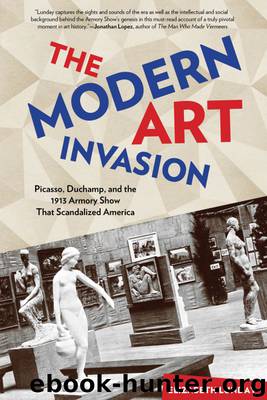Modern Art Invasion by Elizabeth Lunday

Author:Elizabeth Lunday [LUNDAY, ELIZABETH]
Language: eng
Format: epub
ISBN: 9781493000722
Publisher: Lyons Press
Part III
After the Shooting Stopped
CHAPTER 8
Losing Battles
They have turned the society into a Cubist, a Futurist, a Post-Impressionist organization as radical and narrow in its aims as the National Academy of Design is radical and narrow in its aims.
–GUY PÈNE DU BOIS, AMERICAN ARTIST AND CRITIC
March 15, 1913
New York City
In a coincidence only Walt Kuhn might have noticed, the same day the Armory Show held its glorious closing-night party in New York—before packing up for Chicago—the National Academy of Design opened its annual exhibition.
The start of the 1911 Academy show had doomed Kuhn’s hopes for his solo exhibition at the Madison Art Gallery. Now, in a reversal of fortune, the Armory Show cast a giant shadow over the opening of the 1913 Academy Salon—no one could help comparing the two events, and after the Armory Show, the Academy just seemed dull. “There are no Cubist paintings at the spring show of the Academy of Design,” wrote the New York Sun. “This will not surprise anybody, and in fact the main fault to be found with the exhibition is that there are no surprises of any kind.”
The Sun described the show as displaying “orderly vision” and “careful handling of well worn themes” but “hardly any of the volatile notes, the heady waywardnesses, the bold excursions into unfamiliar domains that cheer and vivify.”1 It was hardly a ringing endorsement. The paper’s critic seemed—in a word—bored.
Despite the Academy’s feigned antipathy towards everything modern, the Armory Show did force changes on the Academy—although the institution would never admit it. The jury began to severely limit the number of works admitted so the space wouldn’t be crowded. In one gallery the paintings were even hung in a single row (as they would be today) rather than skied all the way to the ceiling. Artists were finally spared the agony of finding their canvases ten feet above the ground in a dark corner of the room.
However, the jury also responded to the radical work at the Armory by becoming even more academic—they couldn’t compete with progressive art, so, like many conservative politicians, they moved to the right to secure their base. The display was “more conventional, more reserved than ever,” said the New York Press. Taking advantage of the flurry of press coverage associated with the show opening, the Academy announced yet another building plan. No one paid any attention. Coverage of the Academy show vanished from the papers after a few days.
Incidentally, the Academy didn’t get a new building until 1942 when it moved into a mansion on Fifth Avenue donated by the millionaire Archer M. Huntington. It continues to operate there to this day, offering classes, holding exhibitions, and electing prominent artists as Academicians. The Academy remains part of the American art scene, but after 1913 it ceased to wield power. It would never again dominate the lives of artists or determine the taste of the American public.
Kuhn intended to create an alternative to the Academy. He ended up accomplishing far more—he and his fellow artists permanently broke the Academy’s nearly ninety-year hold on American art.
Download
This site does not store any files on its server. We only index and link to content provided by other sites. Please contact the content providers to delete copyright contents if any and email us, we'll remove relevant links or contents immediately.
| Africa | Americas |
| Arctic & Antarctica | Asia |
| Australia & Oceania | Europe |
| Middle East | Russia |
| United States | World |
| Ancient Civilizations | Military |
| Historical Study & Educational Resources |
Cecilia; Or, Memoirs of an Heiress — Volume 1 by Fanny Burney(32434)
Cecilia; Or, Memoirs of an Heiress — Volume 2 by Fanny Burney(31871)
Cecilia; Or, Memoirs of an Heiress — Volume 3 by Fanny Burney(31854)
The Secret History by Donna Tartt(18846)
Sapiens: A Brief History of Humankind by Yuval Noah Harari(14252)
Leonardo da Vinci by Walter Isaacson(13182)
The Radium Girls by Kate Moore(11921)
Sapiens by Yuval Noah Harari(5294)
How Democracies Die by Steven Levitsky & Daniel Ziblatt(5128)
The Wind in My Hair by Masih Alinejad(5034)
Homo Deus: A Brief History of Tomorrow by Yuval Noah Harari(4826)
Endurance: Shackleton's Incredible Voyage by Alfred Lansing(4676)
The Silk Roads by Peter Frankopan(4457)
Man's Search for Meaning by Viktor Frankl(4424)
Millionaire: The Philanderer, Gambler, and Duelist Who Invented Modern Finance by Janet Gleeson(4376)
The Rape of Nanking by Iris Chang(4138)
Joan of Arc by Mary Gordon(4014)
The Motorcycle Diaries by Ernesto Che Guevara(4012)
Hitler in Los Angeles by Steven J. Ross(3900)
